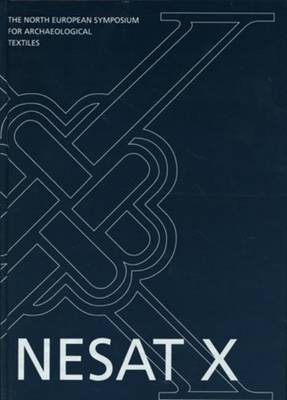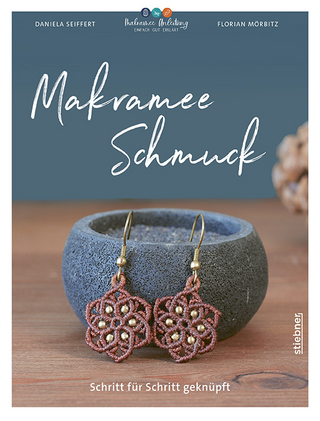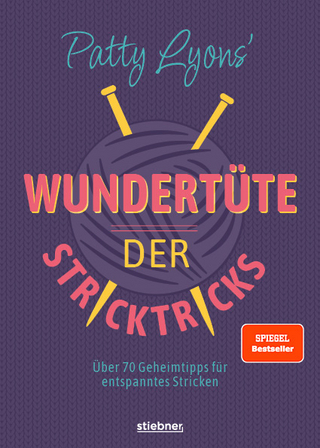
North European Symposium for Archaeological Textiles X
Oxbow Books (Verlag)
978-1-78570-156-6 (ISBN)
The NESAT symposium has grown from the first meeting in 1981 which was attended by 23 scholars, to over 100 at the tenth meeting that took place in Copenhagen in 2008, with virtually all areas of Europe represented. The 50 papers from the conference presented here show the vibrance of the study of archaeological textiles today. Examples studied come from the Bronze Age, Neolithic, the Iron Age, Roman, Viking, the Middle Ages and post-Medieval, and from a wide range of countries including Norway, Czech Republic, Poland, Greece, Germany, Lithuania, Estonia and the Netherlands. Modern techniques of analysis and examination are also discussed.
Margarita Gleba is Assistant Professor at Università degli Studi di Padova, Italy, and an Affiliated Researcher at Ludwig-Maximilians-Universität München, Germany. She has previously held research and teaching positions at University College London, University of Cambridge, the University of Copenhagen and Rutgers University. The author or editor of a number of books, she is also a former Editor of Archaeological Textiles Review. Ulla Mannering is a widely published author with a PhD in prehistoric archaeology from the University of Copenhagen in Denmark. She is one of the initiators of the Danish National Research Foundation’s Centre for Textile Research in Copenhagen and Senior Researcher at the National Museum of Denmark. She is specialized in prehistoric skin and textile production and clothing design in Northern Europe. She has also worked with Roman textiles and clothing. Her current research focuses on resource exploitation and design in Scandinavian Bronze and Early Iron Age societies.
A Brief History of the North European Symposium for Archaeological Textiles (NESAT) (Lise Bender Jørgensen)
Experimental Textile Archaeology (Eva B. Andersson Strand)
The Perfect Picture – A Comparison between 13th-century Art and Two Preserved Tunics (Eva I. Andersson)
Loom-Weights, Spindles and Textiles –Textile Production in Central Europe from the Bronze Age to the Iron Age (Tereza Belanová Štolcová and Karina Grömer)
Difference in the Elaboration of Dress in Northern Europe during the Middle Bronze Age (Sophie Bergerbrant)
Avoiding Nasty Surprises: Decision-Making based on Analytical Data (Lena Bjerregaard, Ute Henniges and Antje Potthast)
Archaeological Textiles from Prague Castle, Czech Republic (Milena Bravermanová)
The Virtual Reconstruction of Archaeological Textiles (Maria Cybulska, Tomasz Florczak and Jerzy Maik)
Terminology Practice in Scandinavian Costume History: Approach to a Methodology for Source based Terminology (Camilla Luise Dahl)
Haberdashery Elements made of Metal Thread: Conservation Problems (Anna Drazkowska)
Current Examinations of Organic Remains using Variable Pressure Scanning Electron Microscopy [VP-SEM] (Andrea Fischer)
Textiles, Wool, Sheep, Soil and Strontium – Studying their Paths: a Pilot Project (Karin Margarita Frei)
Not so much Cinderella as the Sleeping Beauty: Neglected Evidence of Forgotten Skill (Ruth Gilbert)
Die Rekonstruktion des Vaaler Bändchens – ein archäologisches Kammgewebe aus Ditmarschen: Gemeinschaftsarbeit der Wollgruppe des Museumsdorfes Düppel, Deutschland (Annelies Goldmann und Eva-Maria Pfarr)
The Magdalensberg Textile Tools: a Preliminary Assessment (Kordula Gostencnik)
Silk Ribbons from Post-Medieval Graves in Poland (Dawid Grupa)
Silks from Kwidzyn (Poland) (Malgorzata Grupa)
Norwegian Peat Bog Textiles: Tegle and Helgeland Revisited (Sunniva Wilberg Halvorsen)
Smooth and Cool, or Warm and Soft: Investigating the Properties of Cloth in Prehistory (Susanna Harris)
Oriental Influences in Viking Age Denmark: a Kaftan with Belt and Pouches (Anne Hedeager Krag)
A Study of Two Medieval Silk Girdles: The so-called ‘Eric of Pomerania’s Belt’ and the Dune Belt (Viktoria Holmqvist)
Nettle and Bast Fibre Textiles from Stone Tool Wear Traces? The Implications of Wear Traces on Archaeological Late Mesolithic and Neolithic Micro-Denticulate Tools (Linda Hurcombe)
Construction and Sewing Technique in Secular Medieval Garments (Katrin Kania)
Tiny Weaving Tablets, Rectangular Weaving Tablets (Lise Ræder Knudsen)
Warrior’s Clothing in the RigsÞula Poem (Annika Larsson)
Potentials and Limitations on the Application of FTIR Microscopy to the Characterisation of Textiles excavated in Greece (Christina Margariti, Paul Wyeth, Dinah Eastop and Georgianna Moraitou)
Evidence of War and Worship: Textiles in Roman Iron Age Weapon Deposits (Susan Möller-Wiering)
Bewahren und Erfassen – Anmerkungen zum Umgang mit mineralisierten Strukturen auf Metallen in der Denkmalpflege (Britt Nowak-Böck)
Medieval Textiles from Trondheim: An Analysis of Function (Ruth Iren Øien)
Curry-comb or toothed weft-beater? Serrated iron tools from Roman Province of Pannonia (Judit Pásztókai-Szeöke)
Textiles from the 3rd-12th Century AD Cremation Graves found in Lithuania (Elvyra Peceliunaite-Bažiene)
Patterned Tablet-Woven Band – In Search of the 11th Century Textile Professional (Silja Penna-Haverinen)
Social and Economic Aspects of Textile Consumption in Medieval Tartu (Estonia) (Riina Rammo)
Garments for a Queen (Antoinette Rast-Eicher)
Textiles in their Scientific Context –Interdisciplinary Cooperation during the Evaluation of Burial Textiles (Nicole Reifarth)
Our Threads to the Past: Plaited Motifs as Predecessors of Woven Binding Structures (Eva Richter)
The Neolithic Mats of the Eastern Baltic Littoral (Virginija Rimkute)
The Impact of Dyes and Natural Pigmentation of Wool on the Preservation of Archaeological Textiles (Maj Ringgaard and Annemette Bruselius Scharff)
Wear on Magdalenian Bone Tools: A New Methodology for Studying Evidence of Fiber Industries (Elisabeth Ann Stone)
A Bronze Age Plaited Starting Border (Amica Sundström)
Textile Craftsmanship in the Norwegian Mirgation Period (Synnøve Thingnæs)
Textilfunde aus Ausgrabungen in Heidelberg (Vortrag) (Klaus Tidow)
Textile Remains on One Roman Bronze Vessels from Repov (Czech Republic) (Kristýna Urbanova and Helena Brezinova)
Dyes, to be or not to be. Dyeing investigation on Early Iron Age Danish Peat Bog Textiles (Ina Vanden Berghe, Beatrice Devia, Margarita Gleba and Ulla Mannering)
Dressing the Dead: Customs of Burial Costume in Rural Norway (Marianne Vedeler)
The Moment of Inertia: a Parameter for Functional Classification of Worldwide Spindle Whorls from all Periods (André Verhecken)
Elite and Military Scandinavian Dress as Portrayed in the Lewis Chess Pieces (Elizabeth Wincott Heckett)
Headwear, Footwear and Belts in the Íslendingasögur and Íslendingaþættir (Anna Zanchi)
The Use of Horsehair in Female Headdresses of the 12th-13th Century AD (Irita Zeiere)
Two Early Middle Age Caps from the Dwelling Mounds Rasquert and Leens in Groningen Province, the Netherlands (Hanna Zimmerman)
Studies of the Textiles from the Excavation of Pskov in 2006 (Elena S. Zubkova, Olga V. Orfinskaya and Kirill A. Mikhailov)
| Erscheint lt. Verlag | 6.7.2015 |
|---|---|
| Reihe/Serie | Ancient Textiles Series ; 5 |
| Zusatzinfo | 299 illus, 31 tables |
| Verlagsort | Oxford |
| Sprache | englisch |
| Maße | 210 x 297 mm |
| Themenwelt | Sachbuch/Ratgeber ► Freizeit / Hobby ► Handarbeit / Textiles |
| Geisteswissenschaften ► Archäologie | |
| Technik | |
| ISBN-10 | 1-78570-156-8 / 1785701568 |
| ISBN-13 | 978-1-78570-156-6 / 9781785701566 |
| Zustand | Neuware |
| Haben Sie eine Frage zum Produkt? |
aus dem Bereich


